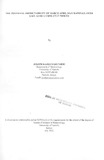| dc.description.abstract | The East African rainfall regime is highly variable and predictability on seasonal time
scales has always been a challenging endeavour. Several predictors have been assembled in the
past for the purposes of seasonal rainfall prediction over East Africa. These include, the MaddenJulian-Oscillation
(MJO), Indian Ocean Dipole (IOD), Quasi Biennial Oscillation (QBO), Sea
Surface Temperature Anomalies (SSTA) and Sea Surface Temperature (SST) gradients. In this
study, the predictability potential of seasonal rainfall anomalies using ITCZ indices was
investigated.
Utilizing the National Centre of Environmental Prediction/National Centre for
Atmospheric Research (NCEP/NCAR) resources of standard pressure level winds for the period
1961-2010 together with the interpolated Outgoing Long Wave radiation datasets from the
National Oceanic and Atmospheric Administration (NOAA) for the period 1976-2010, the
location as well as the magnitude/strength of the Inter-tropical Convergence Zone (ITCZ) was
assessed. The relationship between the location of ITCZ and seasonal rainfall during the MarchMay
season was studied using each of the indices. Meridional and vertical shear of the zonal
wind were computed from the NCEP/NCAR winds on a monthly basis each serving as an index
of ITCZ. The Outgoing Long-wave Radiation (OLR) data were used as proxy for cloudiness
representing the ITCZ band.
It was found that the latitudinal index of ITCZ defined by Outgoing Long-wave Radiation
(OLR), vertical shear of zonal wind and meridional shear of zonal wind indices were good
descriptors of ITCZ location and strength. In Particular, the Outgoing Long-wave Radiation
indices closely mimicked the general pattern of the position of the axis of ITCZ defined from
wind patterns. Examination of the inter-annual variability of ITCZ showed that the locations
. During December, the ITCZ preferred the southern part of its mean location during an El
Niño year and to the north of its mean location during a La Nina year. The ITCZ was found to be
highly variable during the month of March.
Correlation analysis was carried out between the location of ITCZ and the various
indices, i.e. the meridional shear of the zonal wind indices, the Outgoing Long-wave Radiation
indices and the vertical shear of the zonal wind indices on a monthly time scale. The Outgoing
long wave radiation produced higher correlations with monthly rainfall at stations than the other
two indices. However, strong correlations were confined to lag 0. The correlations between the
meridional shear indices and monthly rainfall were rather weak but passed the 95% confidence
test. Moreover, correlations seemed to be higher just before the season and would diminish
further away from the season.
OLR indices were found to account for at most 28% of the variance of March and May
rainfall when ITCZ was located at 12.5˚S in February while the meridional shear of zonal wind
indices accounted for 15% of the variance in March and April when the ITCZ was located at
7.5˚S in January. The vertical shear of zonal wind indices accounted for 10% of rainfall
variability in March. Variance explained during the months of April and May was even lower.
Meridional shifts in ITCZ were also examined with view to establishing tele-connections
between them and monthly rainfall anomalies. OLR indices showed very strong and significant
correlations at lag 0. As for the meridional shear of the zonal wind indices, most correlations
were non-significant during December and January. The vertical shear indices showed rather low
but significant correlations at both lags 1 and 0
ly rainfall prediction. Regions immediately to the west of Lake Victoria, eastern and
coastal parts of Kenya as well as those to the north west of Tanzania showed skillful models
during the months of March with coefficients of determination of 42.5%, 51.2%, 35.9%, 40.7%
and 46.0% respectively. Western Uganda and southern Tanzania showed skilful models during
the month of April while Northern and Western Uganda as well as northern Kenya showed
skillful models during the month of May. In all the cases, the analysis of variance indicated that
all the regression coefficients were significant at the 95% confidence level. March models
showed that the 3 categories namely, below normal, near normal and above normal had equal
chances of being predicted. Below normal category was more reliable. In April, the above
normal category was the most attainable.
During an anomalously wet year, ITCZ structure was found to be well defined and
preferred to sit within the confines of the equatorial parts of the region i.e. the band restricted
itself to between 7.5˚S and 5˚N while during an anomalously dry year, the ITCZ structure was
noisy and seemed to be characterized by presence of other synoptic systems. It was also observed
to oscillate over a wider latitudinal band (between 15˚S and 10˚N), weakening particularly when
approaching the equatorial region during the dry year considered. Notably, there was a difficulty
in separating the Near Equatorial Trough (NET) from the real ITCZ during a dry year. Its
strength was also found to be weak during the transitional months of March, April and May in a
typical dry year. | en |

